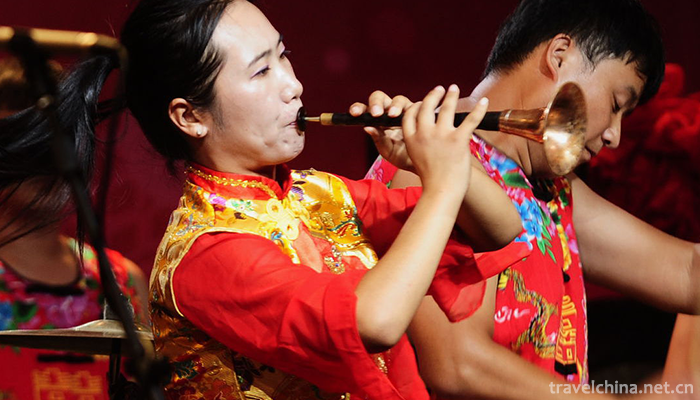Drum and percussion music in Southwest Shandong
Southwest Shandong drum music is a kind of traditional folk instrumental music in Shandong Province. It takes Jiaxiang drum music as a typical representative and mainly distributes in Jining, Zaozhuang, Heze and surrounding areas of Shandong Province.
On May 20, 2006, Jiangzhou Drum Music was listed in the first batch of national intangible cultural heritage list with the approval of the State Council.
Brief introduction
Copper pole suona is a special musical instrument in central and southern Shandong. Southwest Shandong drumming music mainly depends on festival celebrations, weddings, funerals, marriages and other folk activities. It is the most important and representative part of Shandong drum music, and enjoys the reputation of "Suona Township" in China.
Advocacy is a kind of folk instrumental music played by folk wind instruments and percussion instruments. There are four main schools of drumming music in Shandong: Southwest, Central and South, North and East.
historical origin
According to the repertoire often played by Southwest Shandong drumming music (Suona, Xidi's main part), some of them are miscellaneous opera cards since Song and Yuan Dynasty, such as Mianjiang Dragon and Rolling Embroidery Ball, and a large number of minor songs and cards circulated in Ming and Qing Dynasties, such as "Mountain Slope Sheep", "Locking South Branch", "Zhuyunfei", "Yijiang Feng", "Chaotianzi", "Coming to Spring" and "Overlapping Broken Bridge". "Tea Picking" and so on. Therefore, the drum music in Southwest Shandong may have been circulated in the local area as early as the Ming and Qing Dynasties.
artistic characteristics
Firstly, it is a flexible application of a changeable song. There are two main methods used in the multi-play of Southwest Shandong drumming music: strict variation, plate-cavity variation and transfer of finger. The most varied and concentrated music is "Opening the Door" and "Lifting the Flower sedan chair". Taking the folk instrumental music "Open Door" as an example, it can be derived from more than a dozen pieces of music, such as "Open Door with Shang Zi", "Open Door with Rule Zi", "Open Door with Fan Zi", "Open Door with Six Characters", "Open Door with Five Characters", "Da Hetao", "Wind and Snow", "Wedding Music". Various variations based on the cards of Lifting Flower sedan chair include Lifting Flower sedan chair, Baihua Hall, Second Board of Flute, Flute gong, Hundreds of Birds Chao Feng and Quick Slow Flute Winch. Secondly, the characteristic part of the Southwest Shandong advocating music is "Spike". "Spike" is an independent part with comparative expansibility in the whole song. Its standpoint is that it has great improvisation in performance, fine and fragmented sound patterns, free to unfold. When the melody is constantly changing around the central tone, accompanied by rich rhythm and a variety of performing skills, it is a paragraph showing the outstanding talent and superb performing skills of folk performers. In Southwest Shandong, the commonly used playing techniques of drumming and music suona and tin flute are tongue, air-control, air-arch, glide, overtone, depression, bitter tone, etc. .
System composition
There are two systems for the commonly used naming of drumbeats in Southwest Shandong Province, one is to inherit the original local opera's performance fingering transformation, namely, flat tone, overshoot, 28th tone, downward tone and starting tone; the other is the fingering transformation of six-character, ruler tone, upper tone, ordinary tone and five-character tone used in folk drumming music.
Representative works
In addition to the music derived from "Opening the Door" and "Lifting the Flower and sedan chair", there are Suona songs such as "Celebration Order", "Ten Views", "Tea Picking Song", "Jixianbin", "Fengyang Song Gripping Eight Boards", "One Flower", "One River Wind", "Over-the-Move Step Jiao", "Mixed River Dragon", "Mountain Slope Sheep", "Zhumading", "Shuolan Zhi", "Zhuyunfei" and "Luoluo". The flute songs "Shuanghe Feng", "Xiaodi Song", "Aunt Huaxiang Bee Dance", "Yue Diao Huang Ying", "Feng Lai Song", "Happy Newlywed", "Step High" and so on.
Inheritance significance
Southwest Shandong drumming music has unique style, simple and bold, high-spirited, high artistic value, and is loved by experts and the masses. Southwest Shandong advocate music, a popular folk art, has been greatly improved in all aspects through the long-term excavation, collation and promotion of professional cultural workers. It has gradually expanded from the performance of marriage and funeral activities to the performance of large-scale festivals, opening ceremonies, enrollment in the army, enrollment in higher education, and harvest festivals, in order to enrich urban and rural cultural life and meet the cultural needs of the masses. Seeking has played a certain role.

0 Questions
Ask a Question
Your email address will not be published.